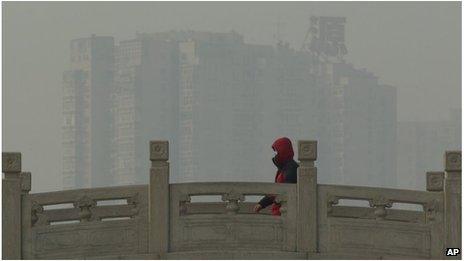Beijing's hazardous pollution sparks Chinese media anger
- Published

Thick smog has hung over Beijing in recent days
Chinese media have reacted strongly to dangerous levels of pollution recorded in many northern cities in recent days.
In the capital, Beijing, at the weekend, air pollution soared past levels considered hazardous by the World Health Organization.
The official People's Daily said the smog was a "suffocating siege" which had to be urgently addressed.
The state-run China Daily said the country had to learn to balance development with quality of life.
Meanwhile, the tabloid Global Times said China was risking serious long-term environmental damage. Smog also dominated social media sites.
Over the week, a dense smog had been gathering over Beijing and some 30 other cities in northern and eastern China, with visibility down to 100m in some places.
Official Beijing city readings on Saturday suggested pollution levels of over 400. An unofficial reading from a monitor at the US embassy recorded levels of over 800.
WHO guidelines say average concentrations of the tiniest pollution particles - called PM2.5 - should be no more than 25 microgrammes per cubic metre. Air is unhealthy above 100 microgrammes and at 300, all children and elderly people should remain indoors.
Once inhaled, the tiny particles can make people more vulnerable to respiratory infections, as well as leading to increased mortality from lung cancer and heart disease.
The Xinhua state news agency said there had been a sharp rise in people seeking treatment at the hospitals in the capital for respiratory problems.
The mother of one eight-month-old baby told the BBC her child had suffered from lung problems for months and that they recently worsened after an outing. Ms Li said she had resorted to keeping a basin of water in the house in the hope it might act as an air purifier.
"It would be helpful if the city has less cars and the city could [place] curbs on car emissions," Ms Li said.
'Poor planning'
On Monday, Beijing authorities said levels had dropped to around 350, but school children were being kept indoors and media reports were warning the public to do the same and to avoid strenuous activity.
The build up of pollution has been put down to a lack of wind and a cold spell, rather than a surge in production of pollutants. But an editorial in the China Daily, external said there was no reason "for us to not reflect on what we've contributed to the smoggy days".
It blamed the pollution on poor urban planning and a rapid increase in car ownership, saying residents had to cut down their use of private cars.
"In the middle of a rapid urbanisation process, it is urgent for China to think about how such a process can press forward without compromising the quality of urban life with an increasingly worse living environment," said the editorial.
"The air quality in big cities could have been better had more attention been paid to the density of the high rises, had more trees been planted in proportion to the number of residential areas, and had the number of cars been strictly controlled. These are the lessons China should learn for its further urbanization."

The public have been advised to avoid strenuous activity outdoors
The People's Daily, the official mouthpiece of the ruling Communist Party, ran a front page editorial demanding: "Let us clearly view managing environmental pollution with a sense of urgency."
The tabloid Global Times, external said measures taken so far to address pollution in China, which it called the "biggest construction site in the world", had failed to alleviate the problem.
It accused the government of dealing with environmental problems in too low-key a way, and called on it to "publish truthful environmental data to the public" to allowed them to help solve the problem.
"The public should understand the importance of development as well as the critical need to safeguard the bottom line of the environmental pollution," it said.
Social media was also dominated by comments on the pollution, with users of the Twitter-like Weibo site saying the government should do more to prevent pollution affecting their lives.
- Published12 January 2013
- Published18 October 2012
- Published21 January 2012
- Published16 May 2012
- Published5 June 2012